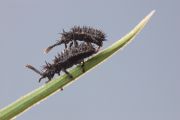Підтримуємо Вільну Україну
 We Support Free Ukraine
We Support Free Ukraine

Biodiversity Map
Taxa

Taxon count: 7
-
Hispa atraSet as tree root ↑
Show taxon data → ⚑
 [67] → Show taxon data
[67] → Show taxon data -
Hispa algiraSet as tree root ↑
Show taxon data → → Show taxon data -
Hispa apteraSet as tree root ↑
Show taxon data → → Show taxon data -
Hispa balbiiSet as tree root ↑
Show taxon data → → Show taxon data -
Hispa cariosaSet as tree root ↑
Show taxon data → → Show taxon data -
Hispa minutaSet as tree root ↑
Show taxon data → → Show taxon data -
Hispa spinosaSet as tree root ↑
Show taxon data → → Show taxon data
-
Arthropodaphylum
Click to switch
to select orders
and filters > -
Hexapodasubphylum
Click to switch
to select orders
and filters > -
Insectaclass
Click to switch
to select orders
and filters > -
Coleopteraorder
Click to set
as the main taxon
and as a base
← of the left panel > -
Polyphagasuborder
Click to set
as the main taxon
and as a base
← of the left panel > -
Cucujiformiaseries
Click to set
as the main taxon
and as a base
← of the left panel > -
Chrysomeloideasuperfamily
Click to set
as the main taxon
and as a base
← of the left panel > -
Chrysomelidaefamily
Click to set
as the main taxon
and as a base
← of the left panel > -
Cassidinaesubfamily
Click to set
as the main taxon
and as a base
← of the left panel > -
Hispinitribe
Click to set
as the main taxon
and as a base
← of the left panel > -
Hispagenus
Click to set
as the main taxon
and as a base
← of the left panel >
species:
Hispa atra
PL
YES
name status: valid name
BioMap ID: 1024341
taxon code: 4673
taxonomy checked: YES
Data on distribution in Poland

Statistics
- Records: 67
- Publications: 36
- Collections: 8
- Publication authors: 35
- Illustrations (iconography): 1
- Photos (specimen/observation): 2
Taxon description
Gatunek rozprzestrzeniony w znacznej części Palearktyki od krajów śródziemnomorskich aż po Danię, Skanię i Białoruską SRR, a na wschód dociera do Mongolii, Tybetu i Chin. W Polsce, jakkolwiek nie jest jeszcze znany z wielu krain, występuje prawdopodobnie na całym obszarze z wyjątkiem wyższych partii górskich. Postacie dojrzałe spotyka się na różnych roślinach zielnych. Larwy mają trzy stadia wzrostowe, żerują w minach wyżeranych w liściach różnych gatunków traw — Gramineae, zwłaszcza gatunków należących do rodzajów perz — Agropyron Gaerth. i wiechlina — Poa L. Przepoczwarczenie odbywa się w minie.
External data sources
- Ostatnie rekordy
-
1115237
 ⊡
⊡ Chrysomelidae: Hispa atra, PL, Wyżyna Krakowsko-Wieluńska, Brama Krakowska, Obniżenie Cholerzyńskie, małopolskie, Kraków m., Kraków, Bronowice, UTM DA14, 2019, leg. M. Syratt
Chrysomelidae: Hispa atra, PL, Wyżyna Krakowsko-Wieluńska, Brama Krakowska, Obniżenie Cholerzyńskie, małopolskie, Kraków m., Kraków, Bronowice, UTM DA14, 2019, leg. M. Syratt -
1050993
 ⊡
⊡ Chrysomelidae: Hispa atra, TR, Malatya Dağlari, Adiyaman, ad Karadut, 2006, leg. A. Lasoń
Chrysomelidae: Hispa atra, TR, Malatya Dağlari, Adiyaman, ad Karadut, 2006, leg. A. Lasoń -
1046706
 ⊡
⊡ Chrysomelidae: Hispa atra, TR, Pülümür Çayi Valley, Tunceli, ad Tunceli, 2004, leg. A. Lasoń
Chrysomelidae: Hispa atra, TR, Pülümür Çayi Valley, Tunceli, ad Tunceli, 2004, leg. A. Lasoń -
1034323
 ⊡
⊡ Chrysomelidae: Hispa atra, PL, Pojezierze Mazurskie, warmińsko-mazurskie, Olsztyn, Gietrzwałd, UTM DE55, 2015, leg. M.S Sowiński
Chrysomelidae: Hispa atra, PL, Pojezierze Mazurskie, warmińsko-mazurskie, Olsztyn, Gietrzwałd, UTM DE55, 2015, leg. M.S Sowiński -
782809
 ⊡
⊡ Chrysomelidae: Hispa atra, PL, Nizina Wielkopolsko-Kujawska, mazowieckie, Gostynin, UTM CD91, 2011, leg. K. Ulanowski
Chrysomelidae: Hispa atra, PL, Nizina Wielkopolsko-Kujawska, mazowieckie, Gostynin, UTM CD91, 2011, leg. K. Ulanowski -
748292
 ⊡
⊡ Chrysomelidae: Hispa atra, PL, Górny Śląsk, P.K. Góra Św. Anny, Ligota Dolna, rez. Ligota Dolna nature reserve, UTM BA99, 2009, leg. T. Blaik
Chrysomelidae: Hispa atra, PL, Górny Śląsk, P.K. Góra Św. Anny, Ligota Dolna, rez. Ligota Dolna nature reserve, UTM BA99, 2009, leg. T. Blaik -
741742
 ×
× Chrysomelidae: Hispa atra, PL (Ścibior 2010b)
Chrysomelidae: Hispa atra, PL (Ścibior 2010b) -
660506
 ⊡
⊡ Chrysomelidae: Hispa atra, PL, Pobrzeże Bałtyku, Gdynia, Orłowo ad Gdynia, UTM CF44, 2007, leg. I. Przybyłowicz
Chrysomelidae: Hispa atra, PL, Pobrzeże Bałtyku, Gdynia, Orłowo ad Gdynia, UTM CF44, 2007, leg. I. Przybyłowicz -
622502
 ⊡
⊡ Chrysomelidae: Hispa atra, PL, Pojezierze Pomorskie, jez. Świdwie ad Szczecin, UTM VV53, 2010, leg. A. Zawal
Chrysomelidae: Hispa atra, PL, Pojezierze Pomorskie, jez. Świdwie ad Szczecin, UTM VV53, 2010, leg. A. Zawal -
620500
 ⊡
⊡ Chrysomelidae: Hispa atra, PL, Nizina Mazowiecka, Warszawa, Ursynów, UTM EC07, 2009, leg. M.W. Kozłowski
Chrysomelidae: Hispa atra, PL, Nizina Mazowiecka, Warszawa, Ursynów, UTM EC07, 2009, leg. M.W. Kozłowski - ... more
- Powiązane publikacje
-
Ścibior R. 2010b. Stonkowate (Coleoptera: Chrysomelidae) nowe dla Podlasia. Część II. Wiad. Entomol., 29(3):181-192.
 full text
full text Show records
Show records -
Burakowski B., Mroczkowski M., Stefańska J. 1991. Chrząszcze – Coleoptera. Stonkowate – Chrysomelidae, część 2. Katalog Fauny Polski, XXIII, 17, Warszawa.
 Show records
Show records -
Borowiec L. 1987. Chrząszcze stonkowate (Coleoptera, Chrysomelidae) rezerwatu Łąki Sulistrowickie i terenów przyległych. Ochr. Przyr., 45:199-208.
 Show records
Show records -
Warchałowski A. 1978. Część XIX. Chrząszcze – Coleoptera. Stonkowate – Chrysomelidae. Podrodziny Halticinae, Hispinae i Cassidinae. Klucze do Oznaczania Owadów Polski, 105, 94c, Warszawa-Wrocław.
 full text
full text Show records
Show records -
Chłodny J. 1978. Studies on the entomofauna of european white birch (Betula verrucosa Ehrh.). [In:] Wiąckowski S.K. (Ed.) Studies on entomofauna of larch, alder and birch in different environmental conditions and its ecological relationships with insect pests of more important forest tree species. Państw. Wyd. Roln. i Leśne, Warszawa. pp. 14-62.
 Show records
Show records - ... more






